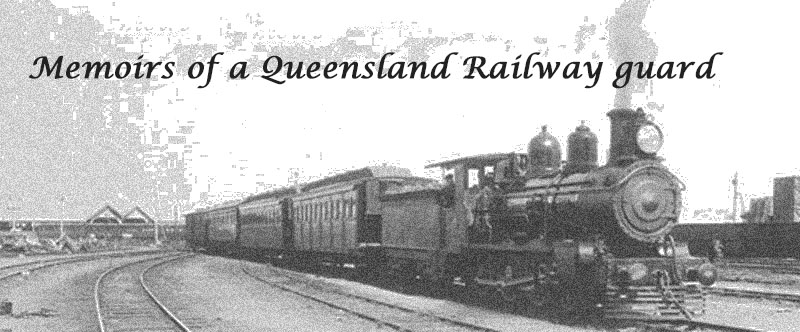|
|
|
|
Introduction PART 1: BYRNES FAMILY ANCESTORS’ CHARTS : (Parents of Peter Byrnes): INDIVIDUAL SUMMARIES
|
The Queensland Times, Friday, Nov 14, 1952: Railway Service A Guard’s Experiences – 7 (by T.A. Byrnes) I came to the conclusion that my athletic career should come to an end, after my race in the Australia 50 kilometres – the exact distance of this race is 31 miles, 2ft, 1.74 in., the distance of the walk on the Olympic Games programme. The race was held in Sydney on September 6, 1930. I had been an active athletic for about 30 years, having been associated with three metropolitan clubs and three country clubs during my career. I had visited Adelaide twice, Melbourne four times and Sydney four times to take part in State championships. My trophy list comprises cups, gold medals, sashes, and others. SONS’ RECORDS My sons took my place in the athletic field. Tom, the eldest, played cricket with the Past Grammar Club, Ipswich. Frank represented Ipswich in three Bulimba Cup matches, also was the tennis champion of Ipswich for three years, winning outright the beautiful Woodford silver cup. Peter, the youngest son, represented the East Ipswich Cricket Club and won the Binnie Cup for the best batting average in the 1940-41 season and the J. Dale Cup for best battling average Ipswich and West Moreton season 1940-41. He won the junior tennis championship of Ipswich and West Moreton from his brother Frank in 1939, also played cricket for St George’s Club in Sydney, 1942-43. SUBURBAN TRAINS I was due to go on the senior passenger trains working just as World War II came in 1939, but owing to the extra trains, a number of shunting trains was done by the passenger guards and excessive hours were worked. After peace was proclaimed in 1945 the senior guards still had to work a certain number of shunting coal trains, and were not given the privilege of passenger train working absolutely, as guards worked previous to World War II. “LOCO DEPARMENT” In looking over my railways career while I was a guard for 40 years, I would desire to make special mention of one class of men in the service was it was my duty to be associated with, and that was the loco staff. I must say I always received the greatest assistance and co-operation from the drivers and fire-men, and it was deep regret when my time as a guard came to an end, that I lost the companionship of these men as a whole. Some of their names I will always member – men like H. Rabbetts, Ambrose Denman, Jim Gee, Tom Smith, and Jim Foreman. EDUCATION FACILITIES In concluding my articles I desire to say that Ipswich, where I spent the great part of my life, has no equal in Australia for its education facilities for the young people, on a population basis. I have travelled while on my annual and extended holidays in all the principal cities and towns from Townsville as far as Adelaide, and I say Ipswich is second to no city as regards its population for schools and colleges. Ipswich, including Bundamba and Brassall, has six State schools besides three Convent Schools. First class secondary education is provided by the Boys’ and Girls’ Grammar Schools, the Christian Brothers’ College, St Mary’s High School and the Technical College. FAMILY LIFE I resided at East Ipswich for about 30 years. Five members of my family passed the scholarship examination. Four passed the Junior and Senior University examinations and one matriculated. Two daughters are certificated nurses, one holds double certificates. APPRECIATION During my term as Guard I have seen 10 chief station masters and a good number of Assistant station masters. The first one I came in contact with was Mr M Carmody who was a practical railway officer. I would be doing an injustice if I omitted to express my gratitude to “The Queensland Times” Editor and staff. After 25 years ago, I contributed a weekly column under the name of “Fleet-foot” for the Local Harrier Club. Many years ago, I was well acquainted with Mr Tom Barker (“Old Sport”), and by a strange coincidence, when I was a junior, before joining the Railway Department, I was readers’ assistant to Mr George Barker in the Government Printing Office, Brisbane. “Old Sport” was a brother of George Barker. THE END
Web editor’s note: Thomas omitted to mention quite a few of his athletics performances in these columns. According to the Queensland Times, of Saturday, June 1, 1968, he also: “In 1920, won the Queensland country half mile race Exhibition Ground… "In 1922, he won the mile [1.6km] walk at the Exhibition Ground in the St Patrick’s Day sports, covering the distance in 7 min 21.2 sec…. "At Adelaide [in 1924] he finished second in the walking championship and at home, won the St Patrick’s Day mile race. "In 1925, he had a string of successes at home and his best effort out of the State was a placing in the Melbourne walking championship held at Richmond Racecourse. "[At 45 years of age] His time of 10 hrs. 42 min. 54 sec for the 50 mile walk at Penrith, New South Wales, earned him sixth place in 1928 and three years later he was still going strong, winning the Queensland Nissen Cup."
|
